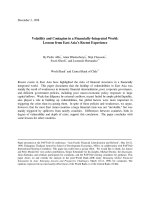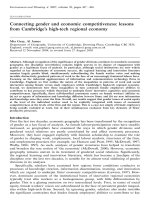Lessons From New American Schools'''' Scale-Up Phase pdf
Bạn đang xem bản rút gọn của tài liệu. Xem và tải ngay bản đầy đủ của tài liệu tại đây (421.32 KB, 159 trang )
LESSONS FROM
NEW AMERICAN
SCHOOLS’
SCALE-UP PHASE
Prospects for Bringing Designs
to Multiple Schools
Susan J. Bodilly
RAND Education
Supported by
New American Schools
R
with
Brent Keltner Susanna Purnell
Robert Reichardt Gina Schuyler
© Copyright 1998 RAND
All rights reserved. No part of this book may be reproduced in any
form by any electronic or mechanical means (including
photocopying, recording, or information storage and retrieval)
without permission in writing from RAND.
Published 1998 by RAND
1700 Main Street, P.O. Box 2138, Santa Monica, CA 90407-2138
1333 H St., N.W., Washington, D.C. 20005-4707
RAND URL: />To order RAND documents or to obtain additional information,
contact Distribution Services: Telephone: (310) 451-7002;
Fax: (310) 451-6915; Internet:
Building on more than 25 years of research and evaluation work,
RAND Education (formerly RAND’s Institute on Education and
Training) has as its mission the improvement of educational policy
and practice in formal and informal settings from early childhood
on.
RAND is a nonprofit institution that helps improve policy and
decisionmaking through research and analysis. RAND’s publications
do not necessarily reflect the opinions or policies of its research
sponsors.
The research described in this report was supported by New
American Schools.
Library of Congress Cataloging-in-Publication Data
Bodilly, Susan J.
Lessons from New American Schools’ scale-up phase :
prospects for bringing designs to multiple schools / Susan J.
Bodilly with Brent Keltner . . . [et al.].
p. cm.
“Prepared for New American Schools by RAND Education.”
“MR-942-NAS.”
Includes bibliographical references (p. ).
ISBN 0-8330-2632-1
1. New American Schools (Organization). 2. School
improvement programs—United States—Case studies. 3. School
management and organization—United States—Case studies.
4. School districts—United States—Case studies. 5. School
environment—United States—Case studies. I. New American
Schools (Organization). II. RAND Education (Institute).
III. Title.
LB2822.82.B636 1998
371.2 ' 00973—dc21 98-20629
CIP
iii
PREFACE
The New American Schools (known as the New American Schools
Development Corporation from 1991 through 1995) is a private non-
profit corporation, created in conjunction with the America 2000 ini-
tiative, to fund the development of new, whole-school designs for
elementary and secondary schools that could eventually be adopted
in schools across the country. After three years of development and
demonstration, NAS chose seven design teams to begin a five-year
effort to promote their designs in multiple schools within a district
and within multiple districts.
During this time, RAND provided analytic support to NAS. RAND
performed an analysis of implementation in the demonstration
schools from 1993 to 1995, which is reported in Lessons from New
American Schools Development Corporation’s Demonstration Phase
(Bodilly et al., 1996). In the scale-up phase, RAND is conducting both
qualitative and quantitative analyses to better understand the effects
of the reform on schools and students.
This report documents the findings from the implementation analy-
sis of the first two years (1995–1997) of the five-year scale-up phase.
This report should interest educational policymakers at all levels of
government, school administrators and teachers, and communities
concerned with improved schooling. The research was supported by
NAS with funds donated by several foundations: The Ford Founda-
tion, the John S. and James L. Knight Foundation, the John D. and
Catherine T. Mac Arthur Foundation, The Pew Charitable Trusts, and
others. The study was conducted under the auspices of RAND Edu-
cation.
v
CONTENTS
Preface iii
Figures ix
Tables xi
Summary xiii
Acknowledgments xix
Abbreviations xxi
Chapter One
INTRODUCTION 1
The Implementation Issue In K–12 Reform 1
NAS Initiative 2
Purpose of This Report 3
Complexity and Uncertainty as a Theme of the
Analysis 3
Organization of the Report 4
Caveats 5
Chapter Two
HISTORY OF NAS AND THE SCALE-UP STRATEGY 7
The Founding of NAS and Its Role in Reform 7
New American Schools Phases 8
Scale-Up Product 10
Design Teams 10
Design-Based Assistance 11
Fee-for-Service 12
Market Definition 12
vi Lessons from New American Schools' Scale-Up Phase
Opportunistic Non-Jurisdiction Approach 12
Jurisdiction Approach 12
Partner Jurisdictions 14
Matching Schools to Designs—The Selection Process 16
The Timetable for Matching and Selection 17
Implications 17
Chapter Three
RESEARCH APPROACH AND METHODS 21
RAND’s Research Agenda 21
Research Questions 22
Conceptual Framework 23
Dependent Variable 23
Independent Variables 24
Case-Study Approach 25
Sample 25
Data Sources and Collection 27
Analysis Plan 29
Measuring the Dependent Variable 29
Measuring the Independent Variables 32
Analysis 33
Caveats 33
Chapter Four
FINDINGS ON PROGRESS TOWARD
IMPLEMENTATION 35
Creating a Scale 35
Level of Implementation 35
Application and Development of a Summary
Dependent Variable 37
Differences in Progress by Schools 38
Chapter Five
THE INFLUENCE OF THE SELECTION PROCESS AND
SCHOOL CLIMATE 43
The District Role in Selection 44
Differences Among Districts in the Selection Process 45
Targeting Specific Schools for Designs 47
Schools’ Incentives to Adopt 48
Influence of the Selection Process 49
Poor Understanding of the Design 49
Forced Choice of Design 51
Contents vii
Influence of the School Climate 51
Internal Tensions 51
Leadership Turnover 52
Previous Reform Experiences 53
Influence of Combined Effect 55
Implications and Lessons Already Learned 55
Chapter Six
INFLUENCE OF DESIGN AND TEAM FACTORS 59
Level of Implementation by Design Team 59
Design and Team Factors and Their Interrelationship 61
Team Stability and Capability to Serve 64
Ability to Communicate the Design Well to Schools 66
Effective Marketing to the District and Ability to Gain
Needed Resources for Implementation 67
Type of Design or Relative Elements Emphasized 70
Design-Team Support 73
Implications 76
Chapter Seven
INFLUENCE OF SCHOOL STRUCTURAL AND
SITE FACTORS 79
Grade Level Influence on Level of Implementation 79
Influence of Other School Site Factors 82
Poverty Level of the School 82
Teacher Mobility 83
Student-Teacher Ratio 83
Implications 83
Chapter Eight
INFLUENCE OF JURISDICTIONAL AND
INSTITUTIONAL FACTORS 85
District and Institutional Influence on Level of
Implementation 85
Jurisdictional and Institutional Factors Considered 86
Factors Considered 87
Influence of Factors on Implementation Level 90
Leadership Support and Centrality of Effort 91
Lack of Crises 93
Culture of Cooperation and Trust 94
School-Level Authority and Autonomy 95
Authority Over Curriculum and Instruction 96
viii Lessons from New American Schools' Scale-Up Phase
Authority Over the Budget 97
Authority Over Personnel 97
Availability of Resources for Transformation 99
Resource Availability 99
Changing Sources of Funds 103
Design Compatible Accountability and Assessment
Systems 104
Implications 105
Chapter Nine
CAVEATS AND CONCLUSIONS 107
The Complex Picture 108
Selection Process and School Climate Factors 108
Design and Team Factors 110
School Structure and Site Factors 110
Jurisdiction and Institutional Factors 110
Overarching Themes 111
Appendix A
BACKGROUND HISTORY OF NEW AMERICAN
SCHOOLS 115
Appendix B
DESCRIPTIONS AND DESIGNS 119
Bibliography 135
ix
FIGURES
2.1 NAS Evolution and RAND Role 10
2.2 Interrelationship in NAS Scale-Up 13
3.1 Conceptual Framework of Analysis 23
4.1 Implementation Levels Assessed at Spring 1997:
Five Elements 39
4.2 Implementation Levels Assessed at Spring 1997:
Eight Elements 40
5.1 Level of Implementation of Poorly Informed
Schools 50
5.2 Level of Implementation of Schools with
Forced Matches 52
5.3 Level of Implementation of Schools with
Internal Tensions 53
5.4 Level of Implementation of Schools with
Principal Turnover 54
5.5 Issues Hindering Implementation 56
6.1 Design Team Levels of Implementation:
Five Elements 60
6.2 Design Team Levels of Implementation:
Eight Elements 61
6.3 Design Team Levels of Implementation in
Year 2 Schools: Five Elements 62
6.4 Design Team Factors Related to
Implementation 63
6.5 Implementation Interventions Emphasized
by Teams 74
7.1 Implementation Level by Grade Level Served:
Year 2 Schools with Five Elements 80
x Lessons from New American Schools' Scale-Up Phase
7.2 Implementation Level By Grade Level Served:
Year 2 Schools with Eight Elements 81
8.1 Jurisdiction Levels of Implementation: Five
Elements 86
8.2 Jurisdiction Levels of Implementation: Eight
Elements 87
8.3 Jurisdiction Levels of Implementation for
Year 2 Schools: Five Elements 88
8.4 Jurisdiction Levels of Implementation for
Year 2 Schools: Eight Elements 89
8.5 Schools’ View of District-Level Support 91
8.6 Average Implementation Spending on Designs 100
8.7 Relative District Resource Support for
Implementation 101
9.1 Factors That Support Implementation 109
A.1 Conceptual Framework of NAS Demonstration
Phase 117
xi
TABLES
2.1 Original NAS Principles and Concepts 9
2.2 NAS Attributes of a Supportive Environment 15
3.1 RAND Sample for Site Visits 27
3.2 Data Types and Sources 28
3.3 Elements of Designs 30
6.1 Relative Emphasis of Each Team During
Implementation 71
xiii
SUMMARY
In July 1991, NAS, a nonprofit corporation funded by the private
sector was established to help existing schools transform themselves
into high-performing organizations. The means for achieving this
transformation has been the use of whole-school designs and design
teams that partner with schools to lend assistance in change. NAS
has had four stages: a competition phase, a phase for further design
development, a demonstration phase, and a scale-up phase.
This report is a formative assessment of the first two years (1995-
1997) of the scale-up phase. The term scale-up describes the NAS
partnership with ten jurisdictions to increase significantly the num-
ber of schools within those jurisdictions that are design-based—that
adopt NAS designs to help improve student performance. The NAS
concept of scale-up includes both increasing the number of schools
using the designs and having a critical mass of design-based schools
within the ten jurisdictions.
RESEARCH QUESTIONS
NAS asked RAND to perform several research tasks during the scale-
up phase. This document addresses only one of those tasks. The
questions addressed in this formative assessment are:
1. Did schools implement the designs and to what extent?
2. Why did some schools make more progress than others toward
implementation goals?
xiv Lessons from New American Schools' Scale-Up Phase
METHODOLOGY
RAND used case studies of schools embedded in districts to deter-
mine the answers to the above questions. It visited a sample of 40
schools in seven districts, reviewed documents, interviewed school
and district staff, and observed some school activities. This data
collection and analysis process was intended to determine the level
of implementation in each school and what had encouraged it or
impeded it. On the basis of these data, we estimated the level of
design implementation in each school. Each school’s implementa-
tion level was assessed against the particular design being adopted.
Selection factors, design and team factors, school structural factors,
and district and institutional factors were analyzed to understand
their effects on the school’s level of implementation.
FINDINGS
Our analysis showed significant variation among the schools in the
level of implementation obtained, which ranged from no implemen-
tation through the stages of planning, piloting, implementing, and
fulfilling. Approximately 50 percent of the schools in the sample
were at the implementing and fulfilling levels; the others were at
lower levels of implementation. Of the 33 schools in the sample that
had been implementing for two years, 18 (approximately 54 percent)
were at the two highest levels. However, 15 schools in the second
year of implementation (close to 45 percent) were still below this
level. Of the seven schools in the sample with only one year of
implementation, three (43 percent) were at least at the piloting
phase.
Selection Process and School Climate Factors
We found that the initial selection process in most districts was hur-
ried and did not always proceed as planned. But some schools fared
better than others in this process. In particular, schools were likely
to make more significant implementation progress within the two-
year time frame we studied if they were well informed, had a free
choice among designs, and did not have strife or a leadership
turnover. The findings point to the importance of this initiation pro-
cess and also to its fragility and easy displacement by other district
Summary xv
and school priorities. NAS and the partner districts have already
significantly changed the selection process in an attempt to promote
free, informed choice of designs by schools.
Design and Team Factors
Our observations reveal that the design teams varied in their ability
to provide strong implementation support to the increased number
of schools in this phase. Higher levels of implementation were asso-
ciated with design teams that had stable leadership and had created
the staff capacity (numbers and quality of staff) to serve the schools;
effectively communicated the designs to schools; gained resources
from districts for implementation; emphasized curriculum, instruc-
tion, student assignment, assessments, and professional develop-
ment; and supported implementation with whole-school training,
facilitators, extensive training days, and common planning time.
NAS is currently working with its teams to increase their capabilities
for the future.
School Structure and Site Factors
We found implementation was slower in the secondary grades than
in the elementary grades. Stronger progress was made in alternative
or restructured secondary schools than in “typically” structured sec-
ondary schools.
District and Institutional Factors
Analysis of districts and their effects on level of implementation
showed that teachers and principals thought both political and
structural factors affected implementation. Higher levels of
implementation were associated with districts that had stable
leadership supportive of the effort, that lacked political crises, that
had a culture of trust between the central office and the schools, that
provided some school-level autonomy, and that provided resources
for professional development and planning.
In many instances the move toward a more supportive environment
was delayed by actions other than those of the districts, such as rules
and regulations of the states. The effort was delayed in several
xvi Lessons from New American Schools' Scale-Up Phase
instances by overwhelming political issues, leadership turnover,
elections, and crisis. Finally, at least some part of the pace of restruc-
turing was due to the scale of the effort. Because all schools would be
potentially affected, districts reviewed policies and practices exten-
sively and deliberately.
Again, NAS and the partner districts have plans under way intended
to improve the support provided to schools.
THEMES AND LESSONS
Several themes come from this analysis. These themes buttress and
are buttressed by similar themes from other studies of implementing
systemic change in general and in K–12 education in particular:
1. The effort at school reform is complex because of the multiple
actors involved, no single one of which controls all the inputs
needed to ensure implementation outcomes. The multiplicity of
actors in the system targeted for change and their different levels
of authority lead to slow progress.
2. Design teams by themselves do not accomplish implementation.
Results depend at least in part on inputs that schools and districts
control or contribute: resources, commitment, time, and effort.
3. The accomplishments are slow to materialize and are often fleet-
ing because of the political nature of the system in which K–12
education is embedded. Local community issues and district
politics—changes in leadership, budget crisis—have an effect and
lead inevitably to adjustments and slowed pace.
4. A stable leadership at both the school and district levels appeared
to be important to teachers, as were clear signals about the prior-
ity to be placed on the effort. But it was the observed leadership by
operators at the school level that proved crucial. They found mes-
sages in many different mechanisms, not just through the verbal
statements of leaders. Resource allocation was a particularly
important message carrier.
Perhaps the most important lesson we have learned (and one we all
learn over and over again) is that there still are no easy answers, no
silver bullets. Elmore and McLaughlin (1988) had it right: K–12
reform is steady work. Much needs to be done to ensure that what
Summary xvii
we observed at the two-year point of the NAS scale-up evolves to the
advantage of students and schools. NAS, its design teams, and part-
ner jurisdictions are making changes designed to improve their
progress toward the goal of high-performing schools. The formative
nature of this report emphasizes that the work has only just begun.
xix
ACKNOWLEDGMENTS
We would like to thank New American Schools, The Ford Founda-
tion, the John S. and James L. Knight Foundation, the John D. and
Catherine T. Mac Arthur Foundation, The Pew Charitable Trusts, and
other donors for their support of our work. This report would not
have been possible without the aid and cooperation of the design
teams, districts, and schools involved in the NAS initiative. People in
each organization gave freely of their time to enable us to understand
the issues involved in implementing whole-school designs in multi-
ple schools within a district and across multiple districts. We thank
them for their efforts and also for their dedication to improving the
educational prospects of all children. We would also like to thank the
many reviewers of this report, especially Tora Bikson and Mike
Timpane.
Many wonderful people have participated in the NAS effort since it
began in 1991. Several have not lived to see the full fruit of their
labor on behalf of this nation’s children. We dedicate this report to
their memory and the work they did. In particular, we remember
with fondness and gratitude Helen Bernstein, Audrey Cohen, Elspeth
Kehl, and Joe Miller.
xxi
ABBREVIATIONS
AC
Audrey Cohen College System of Education
AT Authentic Teaching, Learning and Assessment
CN Co-NECT
EL Expeditionary Learning
MR Modern Red Schoolhouse
NA National Alliance for Restructuring Education
NAS New American Schools
NASDC New American Schools Development Corporation
RW Roots and Wings
1
Chapter One
INTRODUCTION
This report summarizes RAND’s assessment of the New American
Schools (NAS) scale-up initiative in school years 1995–96 and 1996–
97. In the context of NAS, scale-up refers to increasing the number of
schools adopting its “whole-school designs” and ensuring that, in
some districts, a critical mass of schools adopt these designs.
1
This
report offers the public, especially jurisdictions and schools inter-
ested in improving their students’ performance through school
transformation, lessons learned to date from the NAS initiative. The
report describes the context of the NAS scale-up effort, methodology
used to assess it, the implementation progress made within the two-
year period studied, and factors that contributed to that progress. It
explores reasons for variation in progress among schools looking at
the influence of selection factors, design factors, school factors and
district factors on the level of implementation in the schools.
THE IMPLEMENTATION ISSUE IN K–12 REFORM
For many years, K–12 education reformers have been frustrated over
the inability to bring about school reforms that lead to improved stu-
dent outcomes in many schools.
2
Letting schools innovate on their
own appeared to have limited success, resulting in the adoption of
marginal programs, the disappearance of improvements when a
______________
1
This is close to the definition used in Stringfield and Datnow (1998).
2
We do not provide a literature review of education-reform implementation. The fol-
lowing would be helpful to a reader unacquainted with the field: Berman and
McLaughlin (1975), Cuban (1990), Elmore and McLaughlin (1988), Firestone et al.
(1989), Smith and O’Day (1990), and Tyack (1990).
2 Lessons from New American Schools' Scale-Up Phase
principal or sponsor changed, or improvements in one or two
schools, but not many. Imposing state and district mandates
appeared to offer similar meager successes, with programs disap-
pearing when state and district attention waned or when funding
was reduced.
3
The bottom line is that schools and districts have
often faddishly adopted new practices only to find them disappear
within a short time or remain only in a few selected schools in each
district. Thus, a key frustration of those who would improve schools
has been the inability to translate the goal of educating all students
into coherent school-level responses within many schools across the
country or even within many schools across a district. We refer to
this goal as “scale-up”: how to get improved practices into a large
number of schools within a specific period of time.
NAS INITIATIVE
NAS is a nonprofit corporation funded by the private sector to
develop designs for schools that will enable the schools to signifi-
cantly improve student performance. The means NAS chose for
achieving this was to create whole-school designs and teams that
could lend implementation assistance to schools using those
designs.
NAS was founded in July 1991 and committed to a five-year initiative
that included a competitive request for proposals (RFP) and design-
selection process, further development of designs receiving the
awards (July 1992–July 1993), a two-year demonstration period of the
designs in real schools (1993–1995), and a scale-up (1995–1997). The
results of the first three phases of the NAS initiative have been
reported elsewhere.
4
This report concentrates on the scale-up phase.
Prior to the scale-up phase, NAS design teams worked in unrelated
schools chosen by them and located throughout the nation. In the
scale-up phase, NAS and the design teams worked jointly to trans-
form the majority of schools within ten specific jurisdictions. Thus,
to NAS, the term scale-up implies both breadth (an increase in num-
______________
3
The top-down versus bottom-up dilemma has been voiced before; for example, see
Usdan and Schwarz in Education Week (1994), Wilson (1989), and Stringfield et al.
(1997).
4
Bodilly et al. (1995); Bodilly et al. (1996); Stringfield, Ross, and Smith (1996).
Introduction 3
bers of schools in which interventions are taking place) and depth
(concentration in confined political-geographic regions). NAS’s
scale-up definition also means, and this will be stressed throughout
this report, that the NAS intervention began to incorporate and
involve more “levels” of actors in the scale-up phase than it had in
the past phases. These included NAS itself, design teams, schools,
districts, and states.
PURPOSE OF THIS REPORT
The purpose of this report is to provide a formative assessment of
NAS’s scale-up initiative. This report does not stand alone. NAS
asked RAND to perform three major research tasks during the scale-
up phase: a formative assessment of implementation after two years,
an in-depth assessment of changes in classroom practices and stu-
dent work over a three-year period, and a quantitative analysis of
student outcomes and teachers’ and principals’ attitudes over a five-
year period.
This report addresses the first task: provide a formative assessment
of the experience of the first two years of scale-up. The research
questions addressed in this report are as follows:
1. Did schools implement the designs and to what extent?
2. Are there any patterns indicating why some schools made more
progress than others toward implementation goals?
COMPLEXITY AND UNCERTAINTY AS A THEME
OF THE ANALYSIS
An overarching theme emerged from the analysis driven by the
above research questions. The NAS efforts at school-level transfor-
mation combined complex change, innovative processes, and ambi-
tious time lines for change. These attributes of complexity, innova-
tiveness, and pace had a profound effect on the effort.
First, the NAS effort, as presently construed, involves many different
actors: NAS, districts, design teams, schools, teachers, students, par-
ents, etc. In this report, we examine the actions taken by some of
these different actors to understand how their actions supported or









